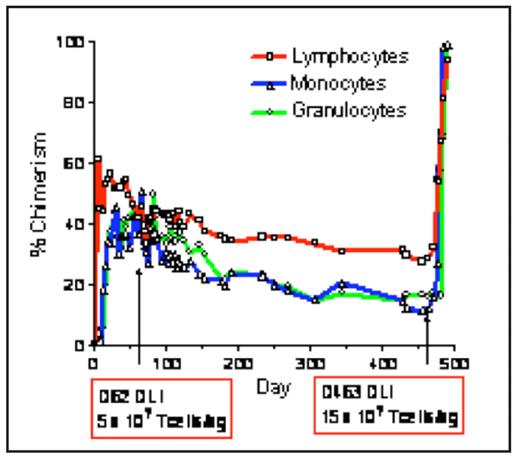Abstract
Non-myeloablative hematopoietic cell transplantation (HCT) followed by delayed donor leukocyte infusion (DLI) is a promising immunotherapeutic approach to the treatment of hematologic malignancies. Major limitations of this approach, however, include the risks of graft failure, graft-versus-host disease (GVHD), and infection. MHC-defined, MGH miniature swine provide a pre-clinical model for studies of HCT. Similar to humans, pigs that receive haploidentical HCT following standard myeloablative conditioning develop severe GVHD or hematopoietic failure. We previously developed a successful haploidentical HCT protocol in miniature swine using a minimally myelosuppressive regimen consisting of a very low-dose of total body irradiation (100cGy TBI) in combination with transient recipient T-cell depletion and a short course of cyclosporine A (CyA), referred to as “ITC”. Strikingly, GVHD is not observed in engrafted animals despite infusion of an enormous number of donor T cells (>5 x 109 T cells/kg) with the initial HCT. Preliminary data demonstrate that regulatory mechanisms play an important role in preventing GVHD and may facilitate engraftment and tolerance in this model. Our data also demonstrate that subsequent DLIs often fails to convert ITC conditioned mixed chimeric swine to full (donor) chimerism. Despite administration of very high numbers of T-cells (5 x 107 T-cells/kg), neither GVHD nor an increase of donor chimerism levels in the peripheral blood post-DLI were observed. We hypothesize that very strong regulatory mechanisms persist in ITC conditioned HCT recipients that not only prevent GVHD but also interfere with DLI-mediated increases in donor chimerism. In the current study, we have investigated 2 approaches to overcome this strong immune regulation and facilitate DLI mediated conversion to full donor chimerism. In the first approach, 2 chimeric animals underwent leuko-depletion in an attempt to reduce putative regulatory cell populations in chimeric recipients prior to DLI. Animals receiving leuko-depletion prior to DLI demonstrated a modest increase (~12%) in thymic chimerism at 4 weeks, suggesting some transient effect. However, a sustained increase in peripheral blood chimerism levels was not achieved. As a second approach, we infused a higher DLI dose (>15 x 107 T-cell equivalents/kg). This dose was calculated based on the dose of DLI given to mixed chimeric mice that results in consistent conversion of low-level chimeras to full donor chimerism without GVHD. Following this high-dose DLI, we observed successful conversion to full donor chimerism in all hematopoietic cell lineages (>95%) within 1 month (Figure 1) without the induction of clinically significant GVHD. The recipient of the DLI underwent a gradual period of conversion between 3 and 4 weeks, with the percent chimerism increasing without a corresponding increase in absolute number of donor cells. A transient leukopenia was observed, suggesting that donor cells were killing recipient lymphohematopoietic cells without inducing tissue damage in the classical GVHD target organs. In summary, these experiments demonstrate for the first time in this large animal model conversion from low to full donor chimerism without GVHD using high-dose DLI in minimally conditioned recipients of haploidentical HCT.
Disclosures: No relevant conflicts of interest to declare.
Author notes
Corresponding author


This feature is available to Subscribers Only
Sign In or Create an Account Close Modal